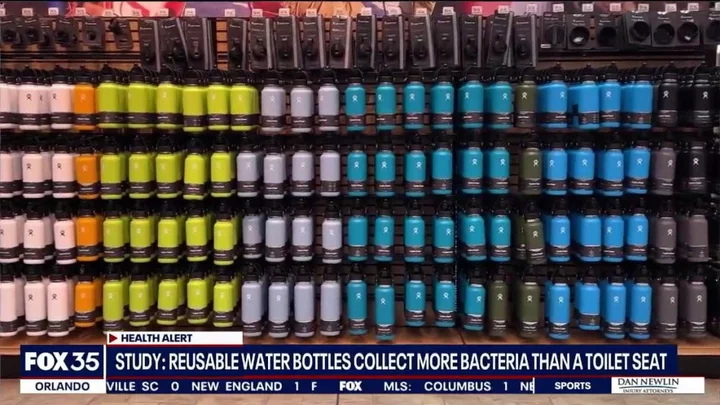
Reusable bottles contain 'more bacteria than toilet seats'
Reusable water bottles tick many boxes. Not only do they help you stay hydrated and help save money, but they also help cut down on single-use plastic. They've almost become a fashion accessory, with chic stainless steel flasks and viral bottles going viral across TikTok. Sign up for our free Indy100 weekly newsletter Trying to hit the NHS-recommended eight glasses of water a day for adults is an excellent idea, of course, but did you know there’s one way your refillable bottle could potentially be detrimental to your health? According to a study from waterfilterguru.com, reusable water bottles contain an average of 20.8m colony-forming units (CFUs) of bacteria, which equates to 40,000 times more than the microbes on a toilet seat. So what might be the consequences if you continuously sip and refill without washing your bottle properly between uses? We asked health experts to talk through the risks… Bottling up bacteria “A common misconception when it comes to reusable water bottle hygiene is that as you’re typically filling it with pure water and it’s only coming into contact with your own mouth, there’s little need to clean it often,” says Dr Donald Grant, senior clinician at The Independent Pharmacy. However, every time you drink from the bottle, you’re transferring bacteria from your mouth, which can then multiply in the container. “Anything that is reusable can be prone to accumulating dirt, dust or debris and, as a result, bacteria,” says private GP Dr Suhail Hussain. “This is exacerbated by the fact water bottles are the ideal environment for harbouring bacteria due to being moist.” Hard-to-reach crevices – for example, inside a screw top or under a flip-up straw – could also develop mould, and then there’s contamination from other sources. “When you store it in a gym bag, for instance, it can pick up bacteria from the interior of the bag or anything else stored in it, while you can also transfer bacteria from your hands to your bottle,” says Grant. “If your bottle has a valve cap, you may need to lift or twist it with your fingers, and this can transfer bacteria you may have picked up from touching other objects or surfaces.” What types of microbes are found in water bottles? “These might be simple commensals such as streptococcus and staphylococcus, which normally live in symbiosis with their host (i.e. us) but can become problematic if they accumulate or the individual is under the weather,” Hussain says. “Bacteria such as E. coli – a common cause of urine and bowel infections – can often colonise the water bottle following repeated handling, such as taking the cap on and off.” These bacteria can potentially cause a variety of issues. “You may become sick and develop gastric illness, such as diarrhoea or vomiting,” Hussain continues. “Gram negative rods – another common bacterium found in unwashed bottles – can lead to urogenital tract infections and pneumonia.” Grant warns: “If there’s a build-up of mould inside the bottle, this can cause allergy symptoms, such as a runny nose, sneezing, or red and itchy eyes. Symptoms might be more severe for someone with asthma.” How often should you wash your reusable water bottle? “To minimise your risk of getting sick, you should ideally clean your water bottle after each use,” Grant says. “As a minimum, you should aim to wash it thoroughly at least a few times a week.” Hot water and washing up liquid are all you need to banish bacteria on a daily. “Fill the bottle with hot soapy mixture and swill around, or leave to soak in a detergent mixture,” Hussain advises. “Remember to pay special attention to lids/caps and screw top regions – use a clean brush [to scrub them].” If you’ve neglected your bottle for a few days and it needs a deeper clean, Grant suggests: “Soak your bottle overnight in a solution of half vinegar and half water. Rinse the bottle and let it dry fully before using it again.” Storage is also important to help minimise nasty microbes. “Where possible, you should keep your water bottle out of germ-rich environments such as your gym locker or sports bag,” Grant says. “You should also avoid filling your bottle with anything other than water, such as protein shakes, energy drinks, or sugar-rich liquids, as sugar can stimulate the growth of bacteria.” Hussain adds: “Don’t leave a water bottle in the sun for long periods or sitting in the cup holder in the car – the mixture of warmth and moisture is likely to make bacterial overgrowth worse.” Have your say in our news democracy. Click the upvote icon at the top of the page to help raise this article through the indy100 rankings.
2023-06-24 17:16
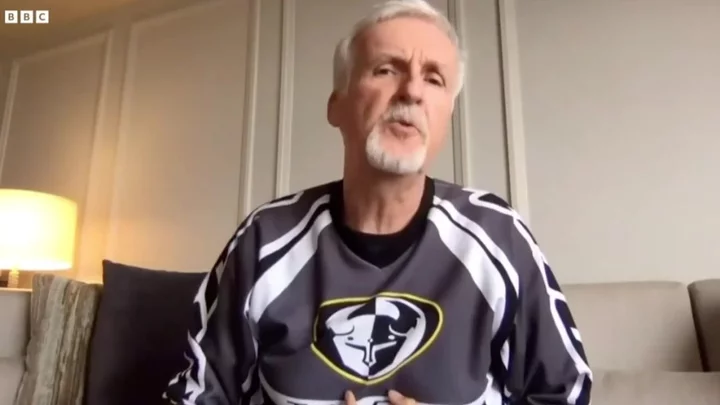
Inside Titanic director James Cameron's obsession with the deep ocean
Public interest in the deep ocean went into a frenzy this week as the search for the doomed Titan submarine played out – and Oscar-winning film director has made no secret of the fact that he is obsessed with the subject. Since it emerged on 22 June that the Titan was destroyed in what US authorities called a “catastrophic implosion”, Cameron has been telling media outlets that he knew what the five-man crew’s fate was since Monday, four days earlier. After calling up his “contacts in the deep submersible community” Cameron said he had already ascertained that the vessel had been destroyed in an implosion. “I felt in my bones what had happened.” Sign up to our free Indy100 weekly newsletter But why does Cameron know so much about the ocean depths? Titanic, Avatar and The Abyss First of all, Cameron has made a lot of films about the bottom of the sea. His 1997 film, Titanic, won 11 Oscars and was the first movie to earn more than $1bn worldwide, and Cameron went deep on his research – literally. The filmmaker has visited the real-life wreck of the Titanic 33 times, making his first trip in 1995 to shoot footage for the film. One of those dives even involved getting trapped with the wreck for 16 hours, with currents of water holding the director’s submarine at the bottom of the ocean. He has even written a book about his experiences, Exploring The Deep, which includes details of his dive journey, photos and maps from his own explorations of the wreck. He told ABC News: “I actually calculated [that] I've spent more time on the ship than the captain did back in the day.” Long before Titanic, Cameron directed The Abyss in 1989. The premise of the film is that an American submarine sinks in the Caribbean – sound familiar? That prompts a search and recovery team to race against Soviet vessels to recover the boat. Meanwhile, the last movie in Cameron’s famous Avatar franchise, The Way of Water, is set on the aquatic ecosystems of a world 25 trillion miles from Earth. "Some people think of me as a Hollywood guy … (but) I make 'Avatar' to make money to do explorations," Cameron told The Telegraph. Going even deeper In 2012, Cameron went a step further, plunging nearly 11km down to the deepest place in the ocean, the Mariana Trench in the western Pacific. The filmmaker made the solo descent in a submarine called the Deepsea Challenger, and it took more than two hours to reach the bottom. The submarine he used was years in the making, designed by Cameron himself with a team of engineers. The trip was only the second manned expedition to the Mariana Trench. The first was in 1960, when US Navy Lieutenant Don Walsh and Swiss scientist Jacques Piccard descended to the ocean floor. “It was absolutely the most remote, isolated place on the planet,” Cameron said in a later interview. “I really feel like in one day I've been to another planet and come back.” He was even underwater when 9/11 happened His obsession with the ocean goes back to age 17, he told the New York Times, when he learned to scuba dive, when he said he felt like he had discovered the "keys to another world”. And between making Titanic in 1997 and Avatar in 2009 Cameron didn’t make a feature film. But he did make documentaries about sea exploration. One of those, 2003’s Ghosts of the Abyss, showed Cameron's travels to the Titanic, while the other, 2005’s Aliens of the Deep, saw Cameron team up with NASA scientists to explore the sea creatures of mid-ocean ridges. Cameron’s fascination even meant he was inside a submersible vessel exploring the Titanic on 11 September 2001, when terrorists flew two passenger jets into the World Trade Centre. It was only after the now-68-year-old director and his crew finished their expedition and returned to the main ship that Cameron learned what had happened. “What is this thing that’s going on?” Cameron asked the late actor Bill Paxton, who played treasure hunter Brock Lovett in the film. “The worst terrorist attack in history, Jim,” Paxton said. Cameron realised he “was presumably the last man in the Western Hemisphere to learn about what had happened,” he told Spiegel in 2012. Have your say in our news democracy. Click the upvote icon at the top of the page to help raise this article through the indy100 rankings.
2023-06-23 20:27

Scientists discover centuries old 'echo' from supermassive black hole
The universe appears to be speaking to us, after a centuries old “echo” from a supermassive black hole was detected by scientists. The black hole located inside the Milky Way became active around 200 years ago and produced a sound that is now being studied. The research was published in Nature and focuses on the black hole named Sagittarius A* (Sgr A*) found 26,000 light-years away from Earth. The noise was triggered when the object consumed gas and dust, with particles moving into the event horizon. The findings could teach us more about the activity of supermassive black holes, which continue to intrigue and confound scientists. Sign up to our free Indy100 weekly newsletter Author of the research Dr Frederic Marin of Strasbourg University said: “It reveals the past awakening of this gigantic object – which is four million times more massive than the Sun. “Our work presents the missing piece of evidence that X-rays from the giant molecular clouds are due to reflection of an intense, yet short-lived flare produced at or nearby Sagittarius A*. These results can further constrain the past activity of the galactic centre.” By their very nature, black holes are difficult to study as they absorb light around them, and these new findings offer insight into a fascinating part of space. Dr Marin said: “To get an idea of the increase in intensity of the X-ray emission when the black hole emerged from its quiescent state, it is as if a single glow-worm hidden in a forest suddenly became as bright as the Sun. “These findings explain why galactic molecular clouds near Sgr A* are shining more brightly than usual. It is because they are reflecting the X-rays emitted by Sgr A* 200 years ago.” Have your say in our news democracy. Click the upvote icon at the top of the page to help raise this article through the indy100 rankings.
2023-06-23 19:28
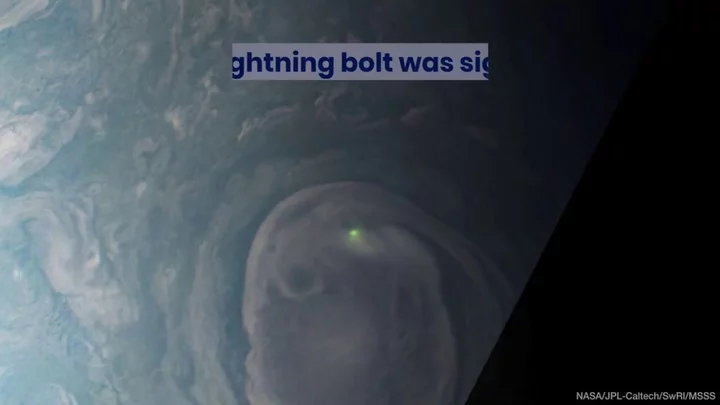
A key building block for human life has been discovered in interstellar space
One of the key building blocks required for human life has been found in the depths of space. Astronomers have been looking out into a region 1,000 light-years from Earth, known as the Perseus Molecular Complex, and they’ve found an amino acid which is essential in human growth. Tryptophan is one of the 20 amino acids required for humans to develop. Babies require it to grow and it’s also important for protein development and muscle function in adults Readings from the Spitzer telescope, which is no longer in use, were crucial to the discovery. Sign up to our free Indy100 weekly newsletter The Perseus Molecular Complex is only visible when viewed through infrared instruments, and tryptophan gives off an identifiable light reading when observed in this way. Dr Susana Iglesias-Groth is from the Instituto de Astrofísica de Canarias and was lead author on the new research. "The evidence for tryptophan in the Perseus molecular complex should encourage additional effort to identify other amino acids in this region, and in other star-forming regions,” Dr Iglesias-Groth said. “It is a very exciting possibility that the building blocks of proteins are widely present in the gas from which stars and planets form – it may be key for the development of life in exoplanetary systems.” The findings were published in the Monthly Notices of the Royal Astronomical Society. It comes after research showed that life forms could potentially be able to survive in the conditions in the clouds above Venus. The key point revolves around the presence of the biosignature gas phosphine, which is often identified as a sign of life. It also posits the idea that potential life forms on the planet could use sulphuric acid the way life forms on Earth use water. Have your say in our news democracy. Click the upvote icon at the top of the page to help raise this article through the indy100 rankings.
2023-06-22 19:27

Scientists just created a new state of matter – here's what that means
Scientists have just created an entirely new state of matter made out of subatomic particles. The bosonic correlated insulator, to be precise, is both a new material and a new state of matter, said researchers from California, Arizona and Japan. There are four fundamental states of matter, liquid, solid, gas and plasma – an electrically charged gas found in situations like stars and lightning strikes. But there are many others when you drill down to quantum level (that means at an atomic and subatomic level). The scientists said this is a new one. Sign up to our free Indy100 weekly newsletter The new material is a lattice-shaped pattern, formed from a layer of the two different types of subatomic particles: bosons and fermions. Bosons are a type of particle which is difficult for scientists to create and manipulate because they do not interact with each other. Fermions are more stable – particles such as electrons – and interact through electrostatic force. The material sees the two different types of particle combining and interacting in a new way, with the particles eventually form into a crystalline state, which in turn creates a material which has an insulating effect. “Conventionally, people have spent most of their efforts to understand what happens when you put many fermions together,” says condensed matter physicist Chenhao Jin from the University of California, Santa Barbara (UCSB). “The main thrust of our work is that we basically made a new material out of interacting bosons.” The new material doesn’t yet have any practical uses, but exotic creations like this help scientists understand how the universe is put together, the team said. “What happened here is that we discovered the correlation that drove the bosons into a highly ordered state,” said physicist Richen Xiong, from UCSB. The scientists think the discovery could lead to them finding more materials like this further down the line. “We know that some materials have very bizarre properties,” said Xiong. “And one goal of condensed matter physics is to understand why they have these rich properties and find ways to make these behaviours come out more reliably.” Have your say in our news democracy. Click the upvote icon at the top of the page to help raise this article through the indy100 rankings.
2023-06-22 18:27

Elon Musk branded 'cowardly' for trying to ban 'cisgender' by researcher who coined the term
The researcher who invented the term 'cisgender' has hit back at "cowardly" Elon Musk for calling the term a slur. 'Cis' or 'cisgender' was coined by now-retired researcher Dana Defosse. They are used to describe someone whose gender identity aligns with the sex they were assigned at birth. It is not offensive or intended to be used as an insult. Defosse first used the term in a 1994 internet forum, before being added to the Oxford English Dictionary much later in 2015. In an essay for HuffPost, Defosse explained how she invented the term: "I knew that in chemistry, molecules with atoms grouped on the same side are labelled with the Latin prefix ‘cis–,’ while molecules with atoms grouped on opposite sides are referred to as ‘trans–.’ So, cisgender. It seemed like a no-brainer," she wrote. On Wednesday (21 June), Musk responded to a user who claimed to have been harassed by trans rights activists. Twitter user James Esses said he "rejected" the terms after receiving "a slew of messages from trans activists calling me ‘cissy’ and telling me that I am ‘cis’ ‘whether or not I like it.’" In response, Musk tweeted: "Repeated, targeted harassment against any account will cause the harassing accounts to receive, at minimum, temporary suspensions. The words “cis” or “cisgender” are considered slurs on this platform." Sign up for our free Indy100 weekly newsletter The tech mogul's response left many social media users baffled, with Defosse saying it came as no surprise after his "ghastly history of attacking trans people." “The post on Twitter has degenerated into a sort of free-for-all for antisemitic and racist tropes, so it sort of fits in with the direction that platform is going," Defosse said. "The fact is, whether or not somebody identifies as cisgender doesn’t negate the fact that cisgender identity is a valid construct. It exists, and it has meaning in how we operate in the world." The retired researcher went on to call his censorship attempt "cowardly". "Banning use of a word that’s part of our daily vocabulary around the world, that appears in the Oxford English Dictionary, it’s a cowardly and futile attempt to censor an idea which is, in my opinion, way bigger and more enduring than anything Musk could hope to offer," she added. Have your say in our news democracy. Click the upvote icon at the top of the page to help raise this article through the indy100 rankings.
2023-06-22 16:26

If you have blue eyes you may have a higher risk of alcoholism
Research from the University of Vermont suggests that there may be a link between those who have blue eyes and alcoholism. The study, conducted in 2015, was led by Dr Arvis Sulovari and assistant professor Dawei Li, and was the first to draw a direct connection between the colour of someone's eyes and their risk of developing alcoholism. Professor Li generated a database comprising of more than 10,000 individuals who have received a diagnosis for at least one psychiatric illness, including conditions such as addiction. Speaking of the conditions, Li - an expert in microbiology and molecular genetics - explained that they were "complex disorders" and that "many genes" and "environmental triggers" were involved. Sign up to our free Indy100 weekly newsletter The researchers used the database to identify those with a dependency on alcohol and discovered an interesting correlation. They found that those with lighter colour eyes - especially blue - had greater rates of alcohol addiction. The researchers even checked three times to be sure of their findings. "This suggests an intriguing possibility that eye colour can be useful in the clinic for alcohol dependence diagnosis," said Dr Sulovari. The study also found that the genetic components that determine eye colour and those associated with excessive alcohol use share the same chromosome. However, more tests and studies are going to have to take place in order for us to gain a deeper understanding of the potential link between eye colour and higher rates of alcohol dependency. Researchers are still unsure as to why there is such a link. With professor Li saying that much of genetics is "still unknown". Have your say in our news democracy. Click the upvote icon at the top of the page to help raise this article through the indy100 rankings.
2023-06-20 23:29
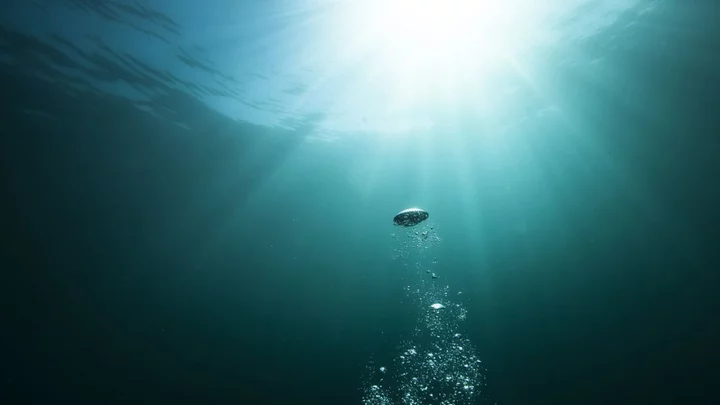
Scientists found the oldest water on the planet and drank it
If you found water that was more than two billion years old, would your first instinct be to drink it? One scientist did exactly that after finding the oldest water ever discovered on the planet. A team from the University of Toronto, led by Professor Barbara Sherwood Lollar, came across an incredible find while studying a Canadian mine in 2016. Tests showed that the water source they unearthed was between 1.5 billion and 2.64 billion years old. Given that it was completely isolated, it marked the oldest ever found on Earth. Sign up to our free Indy100 weekly newsletter Remarkably, the tests also uncovered that there was once life present in the water. Speaking to BBC News, professor Sherwood Lollar said: “When people think about this water they assume it must be some tiny amount of water trapped within the rock. “But in fact it’s very much bubbling right up out at you. These things are flowing at rates of litres per minute – the volume of the water is much larger than anyone anticipated.” Discussing the presence of life in the water, Sherwood Lollar added: “By looking at the sulphate in the water, we were able to see a fingerprint that’s indicative of the presence of life. And we were able to indicate that the signal we are seeing in the fluids has to have been produced by microbiology - and most importantly has to have been produced over a very long time scale. “The microbes that produced this signature couldn’t have done it overnight. This has to be an indication that organisms have been present in these fluids on a geological timescale.” The professor also revealed that she tried the water for herself – but how did it taste? “If you’re a geologist who works with rocks, you’ve probably licked a lot of rocks,” Sherwood Lollar told CNN. She revealed that the water was "very salty and bitter" and "much saltier than seawater." Have your say in our news democracy. Click the upvote icon at the top of the page to help raise this article through the indy100 rankings.
2023-06-20 14:56
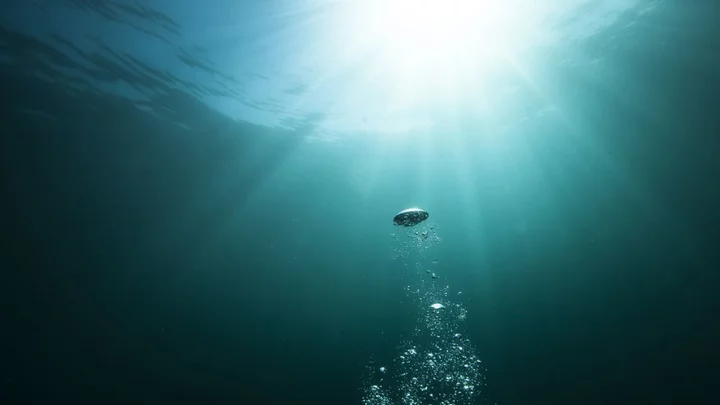
A scientists found the oldest water on the planet and drank it
If you found water that was more than two billion years old, would your first instinct be to drink it? One scientist did exactly that after finding the oldest water ever discovered on the planet. A team from the University of Toronto, led by Professor Barbara Sherwood Lollar, came across an incredible find while studying a Canadian mine in 2016. Tests showed that the water source they unearthed was between 1.5 billion and 2.64 billion years old. Given that it was completely isolated, it marked the oldest ever found on Earth. Sign up to our free Indy100 weekly newsletter Remarkably, the tests also uncovered that there was once life present in the water. Speaking to BBC News, professor Sherwood Lollar said: “When people think about this water they assume it must be some tiny amount of water trapped within the rock. “But in fact it’s very much bubbling right up out at you. These things are flowing at rates of litres per minute – the volume of the water is much larger than anyone anticipated.” Discussing the presence of life in the water, Sherwood Lollar added: “By looking at the sulphate in the water, we were able to see a fingerprint that’s indicative of the presence of life. And we were able to indicate that the signal we are seeing in the fluids has to have been produced by microbiology - and most importantly has to have been produced over a very long time scale. “The microbes that produced this signature couldn’t have done it overnight. This has to be an indication that organisms have been present in these fluids on a geological timescale.” The professor also revealed that she tried the water for herself – but how did it taste? “If you’re a geologist who works with rocks, you’ve probably licked a lot of rocks,” Sherwood Lollar told CNN. She revealed that the water was "very salty and bitter" and "much saltier than seawater." Have your say in our news democracy. Click the upvote icon at the top of the page to help raise this article through the indy100 rankings.
2023-06-19 22:45

No one has been able to handle more than 45 minutes alone in this room
We all crave a bit of peace and quiet every now and then; just some time to be alone with our thoughts. But silence isn’t as golden as we’ve been led to believe, according to the people who’ve been to the quietest place on Earth. You might expect this to be in a remote part of some great desert whereas, in actual fact, it’s located in a research lab in Minnesota. Inside the anechoic chamber at Orfield Laboratories, it is so silent you can hear your own blood flowing and bones moving. Sign up for our free Indy100 weekly newsletter Made of 3.3ft-thick fibreglass acoustic wedges and double walls of insulated steel and thick concrete, the room absorbs 99.99 per cent of sound. The conditions within its Fort Knox-style walls are so intense that the longest amount of time anyone’s been able to endure in there is 45 minutes. “We challenge people to sit in the chamber in the dark,” the lab’s founder Steven Orfield told Hearing Aid Know. “When it’s quiet, ears will adapt. The quieter the room, the more things you hear. You’ll hear your heart beating, sometimes you can hear your lungs, hear your stomach gurgling loudly. “In the anechoic chamber, you become the sound." What he means by this is that, with the absence of external noise, your ears are forced to adapt to unimaginable silence and start to focus inwards on your own mind and bodily functions. Furthermore, after as little as 30 minutes subjects begin to hallucinate. Orfield explained that it is also impossible to stay in the room for more than half an hour without sitting down because a person’s orientation is largely grounded in the sounds they make when moving. "How you orient yourself is through sounds you hear when you walk," he told the Daily Mail. In the anechoic chamber, you don't have any cues. "You take away the perceptual cues that allow you to balance and manoeuvre. If you're in there for half an hour, you have to be in a chair." The Quietest Place on Earth: Orfield Laboratories youtu.be For anyone who reckons they could top that 45-minute record, it is possible to experience the chamber for yourself. The Laboratories offer a tour, named “The Anechoic Experience”, which enables participants to take on the challenge, provided they’re willing to fork out a cool $600 (around £470) per hour for the privilege. The Orfield website states: “We have witnessed many seeming miracles, some of which have explanations and some of which remain mysteries, as a result of time spent in our anechoic chamber. “We remain curious about the nature of the chamber's impact on all people, its therapeutic properties, and how it can influence human perception. While anechoic chambers are traditionally used to study products, ours is becoming also about the people. “The Anechoic Experience is designed to be an opportunity to personally inquire about the chamber's therapeutic and spiritual effects.” We reckon we might be better off just lying in bed with the duvet over our heads next time we want a moment's peace. Have your say in our news democracy. Click the upvote icon at the top of the page to help raise this article through the indy100 rankings.
2023-06-19 21:45
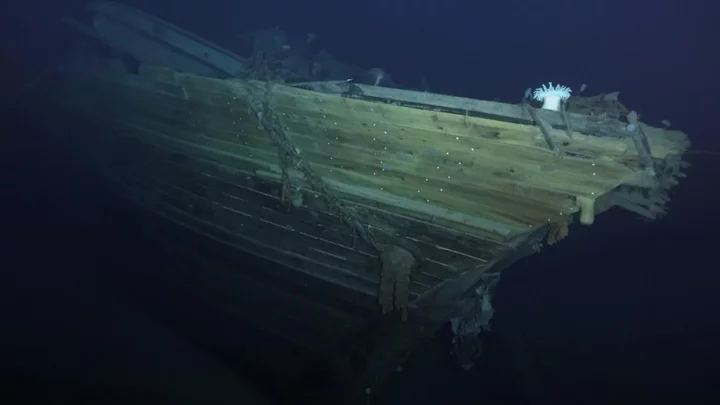
Scientists think there could be an 'anti-universe’ where time runs backwards
It sounds like something straight out of a Christopher Nolan film, but scientists have suggested that there could actually be an 'anti-universe' where time runs backwards. And if you’re anything like us, your brain is probably starting to hurt already. It comes from experts studying symmetries, and the new research is all to do with the fundamentals of symmetry in nature – the most significant of which are charge, parity and time. Bear with us… According to LiveScience, a new paper recently accepted for publication in the journal Annals of Physics suggests that there is a combined symmetry to the entire universe. Sign up to our new free Indy100 weekly newsletter As the research attests, the early universe was so uniform that time looks symmetric going backwards and forwards. The paper argues that the way we understand the world and wider universe around us, moving forwards in time, must also be expanded to include a mirrored version which runs backwards in time. It could also provide a deeper understanding of dark matter, too. The theory suggests that it is an invisible particle which only interacts via gravity and provides a pairing to the electron-neutrino, muon-neutrino and tau-neutrino. The research suggests that the conditions in a mirrored universe where time runs backwards would be full of these paired neutrinos, which would account for dark matter. Of course, we’d never be able to experience time running backwards even if it did definitely exist, but it’s a pretty cool theory none-the-less. It comes after Elon Musk made headlines in the world of science and space travel, after giving his estimation for when humans will land on Mars for the first time. The first moon landing famously took place in 1969, but space enthusiasts have been debating when they think the first Mars landing will be – now, the SpaceX CEO thinks we’ll be up there by 2029. Have your say in our news democracy. Click the upvote icon at the top of the page to help raise this article through the indy100 rankings.
2023-06-19 00:19

Can you find which letter 'G' is written correctly? Most people can't
We use letters every day of our lives, but apparently, there's one lowercase letter that we do not recognise. Psychologists at Johns Hopkins University have discovered that most people aren't aware that there are two types of the lowercase letter g. One of them is the open tail 'g' which most of us would have written out by hand with its image comparable to "a loop with a fishhook hanging from it. Sign up to our free Indy100 weekly newsletter Then, there is the loop tail 'g' which appears in print form e.g. books and newspapers as well as in Serif fonts such as Times New Roman and Calibri - we've all seen this type of letter millions of times, but it seems remembering it is an entirely different challenge altogether. There were 38 volunteers in the study published by the Journal of Experimental Psychology: Human Perception & Performance and they were asked to list letters that they thought had two variations in print. In the first experiment, "most participants failed to recall the existence of looptail g" while only two people could write looptail g accurately. "They don't entirely know what this letter looks like, even though they can read it," co-author Gali Ellenblum said. Next participants were asked to look for examples of the looptail g in the text and were asked to reproduce this letter style after this and in the end, only one person could do this while half the group wrote an open tail g. Finally, those taking part in the study were asked to identify the letter g in a multiple-choice test with four options of the letter where seven out of 25 managed to do this correctly. So how can we know a letter but not recognised it? It could be to do with the fact we are not taught to write this kind of 'g," according to Michael McCloskey, senior author of the paper. "What we think may be happening here is that we learn the shapes of most letters in part because we have to write them in school. 'Looptail g' is something we're never taught to write, so we may not learn its shape as well," he said. "More generally, our findings raise questions about the conditions under which massive exposure does, and does not, yield detailed, accurate, accessible knowledge." In a play-along video on John Hopkin's YouTube channel, four different g's labelled from one to four appear on the screen where it asked viewers to guess which is the correct looptail 'g'. (*Spoiler ahead*) The correct answer is number 3. Meanwhile, this study has also led research to question the impact that writing less and using more devices has on our reading abilities. "What about children who are just learning to read? Do they have a little bit more trouble with this form of g because they haven't been forced to pay attention to it and write it?" McCloskey said. "That's something we don't really know. Our findings give us an intriguing way of looking at questions about the importance of writing for reading..." Have your say in our news democracy. Click the upvote icon at the top of the page to help raise this article through the indy100 rankings.
2023-06-18 23:59
